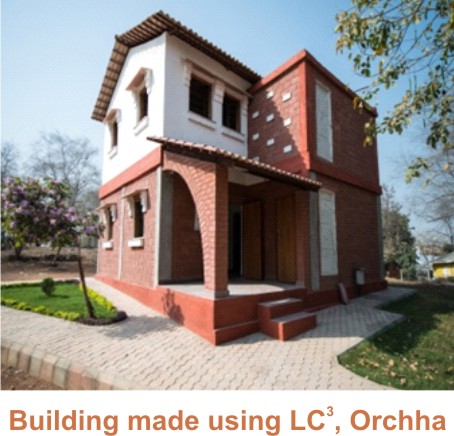|
LC3TRC : Paving the Path Towards Sustainability
Cement production in India is growing exponentially. It is being predicted that it will cross 500 MTPA mark by 2025 from the 2017 figure of 286 MTPA1. Cement manufacturing consumes very large quantities of natural resources. Availability of natural as well as alternate resources for cement manufacturing is becoming erratic day by day. Under these circumstances, the country is in a dire need of diversification of its cement portfolio. Business advantages of manufacturing LC3 will be immense as its integration in existing processes of commercial cement plants is easy as calcined clay-clinker systems are already in use. Therefore, capital investments are expected to be low since existing equipment can be used to manufacture LC3. Coal and limestone consumption is also reduced which helps in lowering the cost of production. The wide availability of china clay provides an opportunity for cement companies to enhance production capacities by utilisation of LC3 technology with minimum investment on alternative raw materials and its transportation. LC3 Technology Resource Centre (LC3TRC) The LC3 Technology Resource Centre (LC3TRC) in India has been set up by TARA, the social enterprise wing of the Development Alternatives Group with the purpose of providing access to state-of-the-art knowledge on LC3 and related products to industries and academia. Unique value proposition offered by LC3TRC is the delivery of comprehensive low carbon solutions to cement companies, pre-fab enterprises and clay calciners in India and abroad. Equipped with modern equipment, testing facilities and scientific personnel, the centre will provide consultancy services for establishing feasibility of LC3 in cement production and testing facilities for use of LC3 in concrete and concrete applications; material characterisation and calcination for use of clay resources in LC3 formulation. The centre is also equipped to supply LC3 based certified materials to research institutions. Research partners of LC3TRC include premier research institutions such as Indian Institute of Technology Delhi, Indian Institute of Technology Madras, Indian Institute of Technology, Bombay and École Polytechnique Fédérale de Lausanne (EPFL), Switzerland. Implementation partners include Centro de Investigación Desarrollo de Estructuras Materiales (CIDEM) Cuba and Technology and Action for Rural Advancement (TARA) India. Industrial collaborators include J.K. Lakshmi Cements Ltd, Dalmia Bharat Cements Ltd and Supertech Ltd. While the driving factor for LC3TRC is the significant reduction in CO2 emission and reducing use of virgin resources in construction sector, it’s mission is to innovate green business solutions which will encourage its acceptance among the producers, consumers and decision makers through knowledge, information and global expertise. The strategy intends to inspire 10% of global producers to adopt and integrate this green business solution in their existing and emerging methods of cement production. LC3TRC aims to deliver state of the art knowledge services and technology support for LC3 to cement companies, china clay suppliers and pre-fabricated building material manufacturers by diversifying their product portfolio and reducing the clinker factor. This will help save carbon emissions, energy, coal and limestone by: LC3TRC partners have established brand recognition through their years of work on the product. LC3 minimises the supply risks by diversifying the product portfolio and enhancing the ‘green’ brand value of companies. LC3TRC can be contacted through mail id: smaity@devalt.org/ amehta@devalt.org. ■
Barsa Baisali Panda
Reference |
 Limestone Calcined Clay Cement branded as LC3 is a novel cement mix which uses 45% clinker less as compared to Ordinary Portland Cement. Clinker is one of the most energy and resource intensive constituents of cement. In LC3, about 50% clinker is replaced with calcined low-grade china clay (non-ceramic grade). Resource mapping studies in India have shown that china clay is widely available in India. The other ingredients of this LC3 cement are low grade limestone (non-cement grade) and gypsum. Reduction of clinker in LC3 fabrication offers environmental advantages through resource efficiency. Life cycle assessment studies have depicted about 30% CO2 emissions can be reduced and 50% natural resources can be saved by manufacturing LC3.
Limestone Calcined Clay Cement branded as LC3 is a novel cement mix which uses 45% clinker less as compared to Ordinary Portland Cement. Clinker is one of the most energy and resource intensive constituents of cement. In LC3, about 50% clinker is replaced with calcined low-grade china clay (non-ceramic grade). Resource mapping studies in India have shown that china clay is widely available in India. The other ingredients of this LC3 cement are low grade limestone (non-cement grade) and gypsum. Reduction of clinker in LC3 fabrication offers environmental advantages through resource efficiency. Life cycle assessment studies have depicted about 30% CO2 emissions can be reduced and 50% natural resources can be saved by manufacturing LC3.